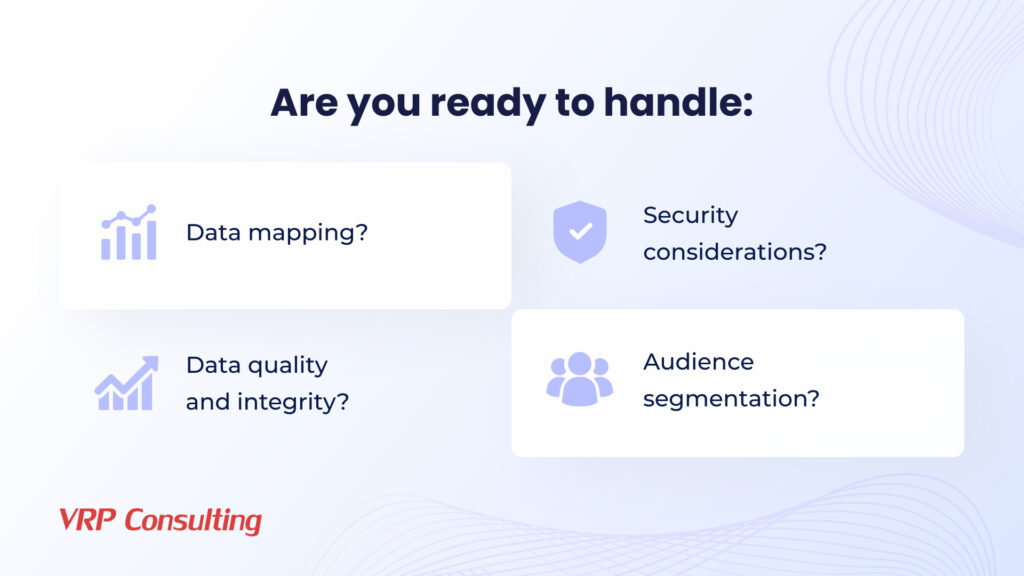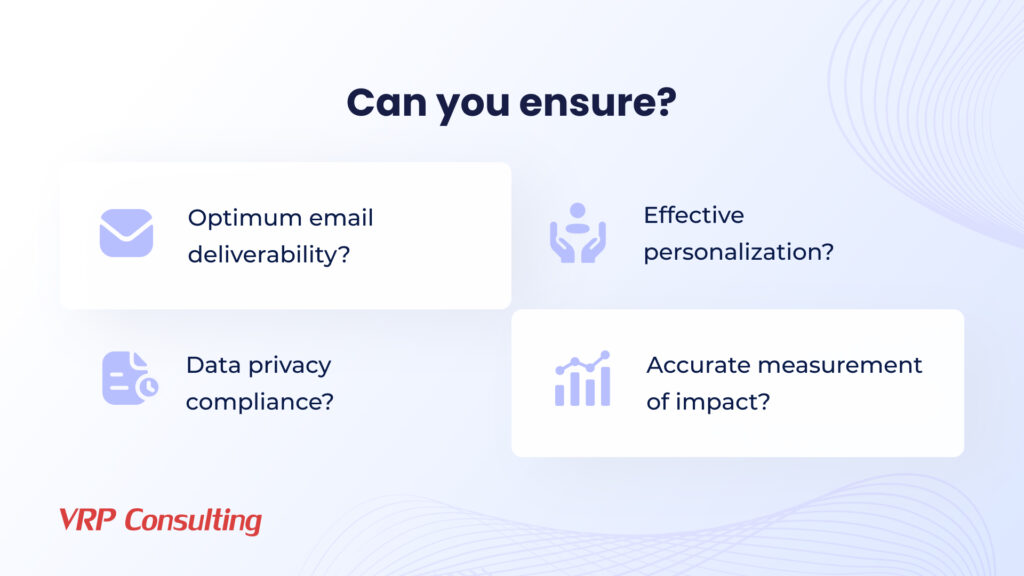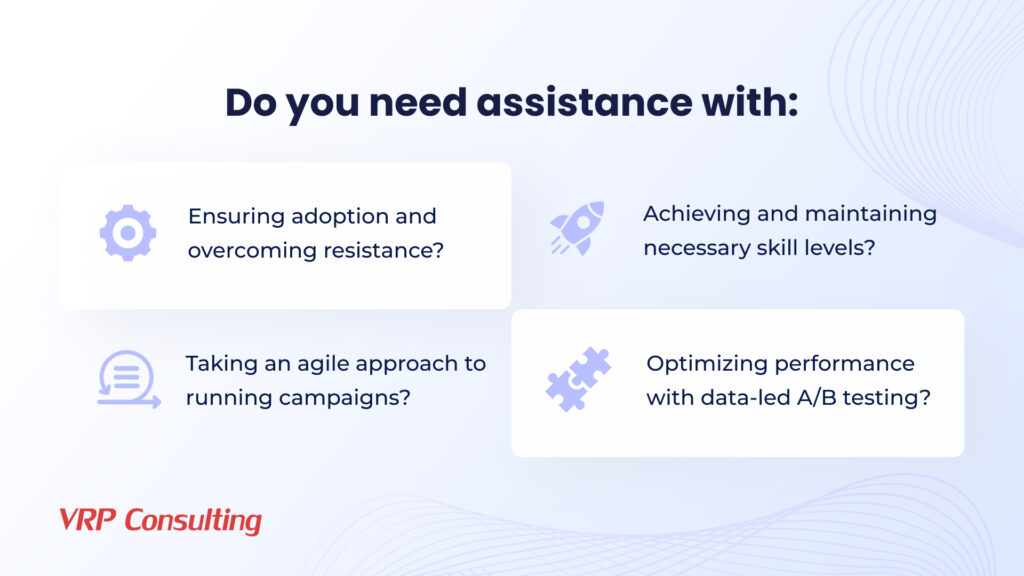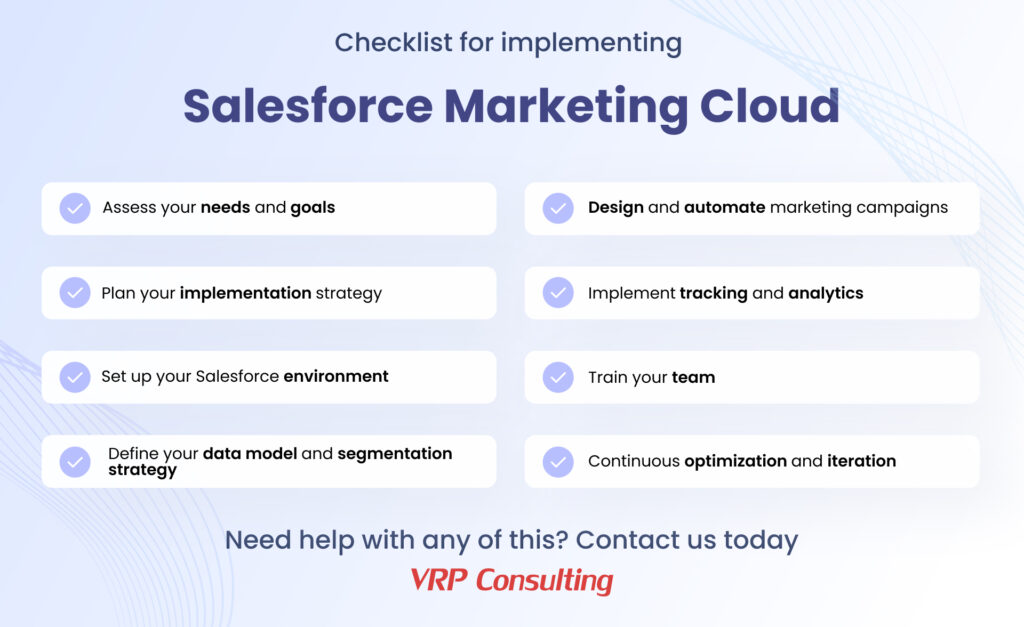Learn all about lead scoring in Salesforce Marketing Cloud Account Engagement (MCAE). Find out what lead scoring is, how it works in MCAE, how to implement it, tips for lead scoring success and more.
Businesses and nonprofit organizations everywhere have implemented Salesforce® Marketing Cloud to streamline and boost their marketing efforts and engage with their audience more effectively. However, deploying Marketing Cloud requires careful planning and execution to harness its full potential. In this Salesforce Marketing Cloud implementation guide, we’ll provide you with a comprehensive, step-by-step walkthrough for rolling out Marketing Cloud successfully, along with valuable tips and advice to ensure a smooth transition.
At every step in our Marketing Cloud implementation guide, we’ll also reveal some key factors to consider. These are often matters you might need help with – parts of the Marketing Cloud implementation we’ve found organizations frequently overlook or struggle to achieve, and for which they benefit from our assistance.
Need to learn more about Marketing Cloud first?
If you’re still learning about Salesforce Marketing Cloud, and you’d like to know more before you implement it, we can help. VRP Consulting has provided other articles that can give you all the basic details you’re looking for.
Our article, “What is Salesforce Marketing Cloud” tells you what Marketing Cloud is used for, what’s included in Marketing Cloud and more – including answers to a range of the most frequently asked questions. If you want a complete introduction to Marketing Cloud, make sure to read it.
Another VRP article, “Top 10 Salesforce Marketing Cloud features” delves into deeper detail, describing our selection of Marketing Cloud features that often provide the most value to those who implement it. The article also provides example use cases alongside every feature, covering a range of scenarios, organization types and industries.
Already up to speed? Then let’s start the Salesforce Marketing Cloud implementation guide:
The 8 steps to implement Salesforce Marketing Cloud:
1. Assess your needs and goals
First things first. Before diving into the implementation process, take the time to assess your organization’s specific marketing needs and goals. Make sure to consider factors such as your target audience, current marketing strategies, and areas for improvement. This initial step will help you tailor your Marketing Cloud implementation to align with your objectives, ensuring maximum ROI (return on investment). Salesforce consultants can often provide valuable expertise in this crucial “discovery” phase.
You might need help with…
- Data cleanliness: Ensure your existing data is clean and organized before migrating it to Marketing Cloud to avoid issues with segmentation and targeting.
- Resource allocation: Allocate sufficient resources, including time and personnel, for the assessment phase to gather comprehensive insights into your marketing requirements.
2. Plan your implementation strategy
Now it’s time to develop a comprehensive implementation strategy that outlines key milestones, timelines, and resources required for each stage of the process. Identify potential challenges and mitigation strategies to address them proactively. Consider factors such as data migration, integration with existing systems, and user training to ensure a seamless transition to Marketing Cloud. Would you be likely to need support with any/all of these?

You might need help with…
- Integration complexity: Assess the complexity of integrating Marketing Cloud with existing systems, such as CRM platforms or third-party applications, and plan accordingly to minimize disruption.
- Change management: Implement strategies to manage organizational change effectively, including communication plans, stakeholder engagement, and training programs.
3. Set up your Marketing Cloud
Your Marketing Cloud needs to be properly configured to meet your needs, which includes users’ roles and permissions, security settings, domain setup and SSL certificates for account branding. If you already use the Salesforce platform and/or other Salesforce clouds, you will also need to ensure that your wider Salesforce environment is properly configured to integrate with Marketing Cloud, synchronizing data between Salesforce and Marketing Cloud. You can use Salesforce’s resources and documentation to guide you through this process, but you may need assistance from a Salesforce Partner.
You might need help with…
- Data mapping: Map out the data fields between Salesforce and Marketing Cloud accurately to ensure seamless data synchronization and consistency.
- Security considerations: Implement robust security measures to protect sensitive customer data and comply with privacy regulations, such as the European Union’s General Data Protection Regulation (GDPR) or the California Consumer Privacy Act (CCPA).
4. Define your data model and segmentation strategy
Next, it’s time to establish a robust data model within Marketing Cloud to organize and segment your audience effectively. Define data attributes, such as demographics, behaviors, and preferences, to personalize your marketing campaigns and improve targeting accuracy. Utilize segmentation tools within Marketing Cloud to create dynamic audience segments based on predefined criteria. Do you know how to do all of the above?

You might need help with…
- Data quality control: Implement processes to maintain data quality and integrity, such as regular data cleansing and validation checks.
- Segmentation logic: Develop clear segmentation logic based on customer personas, lifecycle stages, or behavioral triggers to ensure relevant and personalized messaging.
5. Design and automate marketing campaigns
You want to give your marketing campaigns the best chance of success. So, create visually appealing email templates and landing pages using Marketing Cloud’s drag-and-drop interface or HTML coding capabilities. Leverage automation features, such as journey builder and automation studio, to orchestrate personalized customer journeys across multiple channels. Test your campaigns thoroughly to ensure optimal performance and deliverability. Once again, an expert Salesforce Partner can assist you here if necessary.
You might need help with…
- Email deliverability: Monitor email deliverability rates and implement best practices, such as sender authentication and list hygiene, to avoid spam filters and maximize inbox placement.
- Personalization pitfalls: Avoid counterproductive over-personalization or irrelevant messaging by carefully segmenting your audience and tailoring content based on their preferences and behaviors.
6. Implement tracking and analytics
How do you measure your success? Set up tracking parameters and analytics tools within Marketing Cloud to monitor the performance of your campaigns in real-time. Track key metrics, such as open rates, click-through rates, and conversion rates, to measure the effectiveness of your marketing efforts. Use insights from analytics reports to refine your strategies and optimize campaign performance.

You might need help with…
- Data privacy compliance: Ensure compliance with data privacy regulations when collecting and analyzing customer data, including obtaining consent and providing opt-out mechanisms.
- Attribution modeling: Implement robust attribution models to accurately measure the impact of your marketing campaigns across different touchpoints and channels.
7. Train your team
Your people need to know how to use Marketing Cloud – and use it effectively. Provide comprehensive training and support to your team members to ensure they are proficient in using Marketing Cloud effectively. Offer hands-on workshops, online tutorials, and access to Salesforce’s Trailhead platform to help users familiarize themselves with the platform’s features and functionalities. Encourage continuous learning and experimentation to drive innovation and growth.
You might need help with…
- User adoption challenges: Address potential resistance to change by emphasizing the benefits of using Marketing Cloud and providing ongoing support and training resources.
- Skills gaps: Identify any skills gaps within your team and address them. If hiring in-house isn’t cost-effective, consider outsourcing or managed services, or training programmes for existing staff.
8. Continuous optimization and iteration
This “final step” doesn’t actually mark the end at all. It’s the start of a new, ongoing, open-ended phase of improvement. Making the most of Marketing Cloud is an ongoing process that requires continuous optimization and iteration. Regularly review and analyze campaign performance data to identify areas for improvement and optimization. Experiment with new features and techniques to stay ahead of the curve and maintain a competitive edge in the ever-evolving digital landscape.

You might need help with…
- Agile approach: Adopt an agile approach to marketing campaign management, allowing for quick iterations and adjustments based on real-time data and insights.
- A/B testing: Implement A/B testing methodologies to compare different campaign elements and optimize performance based on empirical data rather than assumptions.
Do you need help from a Salesforce Partner?
Implementing Salesforce Marketing Cloud can deliver huge rewards for your organization, all driven by transformed processes, valuable new insights and smarter, data-driven campaigns. But, as we’ve explored here, it also comes with its complexities and challenges, and some of these may be beyond the expertise you have in-house.
Don’t worry – you don’t have to go it alone. Engaging a leading, certified Salesforce Partner such as VRP Consulting can provide you with the vital expertise and support needed to navigate the implementation process smoothly. We bring a wealth of experience and best practices to the table, ensuring that your Marketing Cloud implementation is tailored to your unique business needs and goals.
That’s not all. Taking on a skilled Salesforce Partner can help accelerate the implementation timeline, minimize risks, and maximize ROI. By leveraging the specialized skills and knowledge of a Salesforce Partner, you can unlock the full potential of Marketing Cloud and drive sustainable growth for your business. We at VRP Consulting would be very glad to help you make sure your Salesforce Marketing Cloud implementation is a success.
For organizations such as smaller businesses and nonprofits, we also offer QuickStart implementation packages. With a QuickStart, those with the most challenging budgets and simplest needs can get up and running with Marketing Cloud quickly and cost-effectively in as little as four weeks. We will be happy to discuss which is the right option for you.
We hope our Salesforce Marketing Cloud implementation guide is useful
Thank you for reading this guide. We hope that it’s given you a better understanding of the many ways in which you need to plan and prepare, and the steps you need to take, to give yourself the best chance of success. To summarize the information covered here, we’ve provided a handy Salesforce Marketing Cloud implementation checklist – see below.

If you need advice or assistance for any aspects of your Salesforce Marketing Cloud implementation, please get in touch. Our experts at VRP Consulting’s dedicated Salesforce Marketing Cloud Practice have helped all kinds of businesses and nonprofits, all over the world, to achieve all the value of Marketing Cloud in the smoothest and most cost-effective way.

